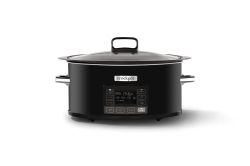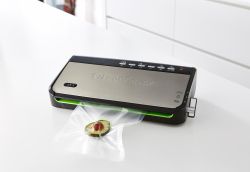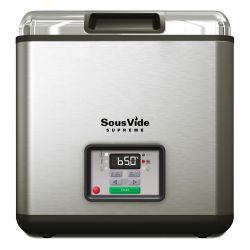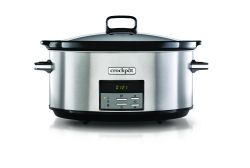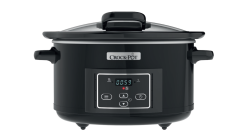My food seems to be cooking too fast – what should I do?
If cooking the High setting, and food has been cooking for less than 5-6 hours, turn the setting to low to slow down the cooking process.
What’s the difference between "Low" and "High" cooking?
Both High and Low stabilize at the same temperature; it is just a matter of how long it takes to reach the simmer point. Once food reaches the simmer point, total cook time is dependent on cut and weight of meat to reach the point of maximum flavour and texture potential. (Most dishes can be prepared on either High or Low.)
What are the typical cook times for Crock-Pot® slow cookers?
Typical cook time for Crock-Pot® slow cookers to reach simmer point (100°C): Low: 7-8 hours to reach the simmer point High: 3-4 hours to reach the simmer point.
How do I convert cook times between High and Low?
Below is a conversion chart to illustrate comparative cook times for High and Low. It is not recommended to convert recipes with cook times less than 7-8 hours on Low or 3-4 hours on High.
|
HIGH |
LOW |
|
3 hours |
7 hours |
|
4 |
8 |
|
5 |
9 |
|
6 |
10 |
|
7 |
11 |
|
8 |
12 |
What are the typical slow cooker food loads and their respective cook times?
|
Meat Cut |
Meat Weight |
Low Cook Time |
High Cook Time |
|---|---|---|---|
|
Large Pork Roast* |
2.5-3kg |
9 ½ hours |
7 ½ hours |
|
Pork Loin |
1.5kg |
6 hours |
5 hours |
|
Poultry** |
2.5-3kg |
7 ½ hours |
6 ¼ hours |
|
Beef Roast |
1.5kg |
8 hours |
5 ¾ hours |
|
Stew Meat |
1.5kg |
6 hours |
4 ¾ hours |
|
Fish*** |
1kg |
3 ½ hours |
1 ½ hours |
Note: All cook times are approximate. Appropriate cook time varies according to specific meat characteristics for fat content and connective tissue as well as other ingredients added to dish including liquid, size of meat cubes, type of vegetable, size of vegetable dice, how high slow cooker is filled, etc.
* Pork butt, pork shoulder
** Whole chicken, Bone-in turkey breast
*** If fish is stirred in after Crock-Pot® slow cooker has been fully heated to stabilization/simmer point, it will cook within 15-30 minutes.
How much should I fill my Crock-Pot® slow cooker?
A Crock-Pot® slow cooker should be at least ½ full to ¾ full for best results.
Does the water evaporate in a Crock-Pot® slow cooker?
Slow cookers have very little evaporation. If making a stove top recipe for a soup, stew, or sauce reduce liquid or water. If the meal result is too thick, liquids can be added later.
Can I open the lid or stir when the food is slow cooking?
Due to the nature of a slow cooker, there is no need to stir the food unless it specifically says to in your recipe. In fact, taking the lid off to stir food causes the slow cooker to lose a significant amount of heat, extending the cooking time required. Therefore, it is best not to remove the lid for stirring.
Can I reheat in my Crock-Pot® slow cooker?
Reheating is not recommended. However, the stoneware is microwave proof and oven proof up to 200°C. Many slow cooker dishes are just as good the day after before the flavours have had time to blend together.
Should I pre-brown meat?
Some people prefer the convenience of not having to brown meat before adding to the slow cooker. Brown/Sear meats in a skillet, prior to adding to slow cooker. This will create greater depth of flavour to any dish as well as melt out fat that can be poured off before slow cooking. Pre-browning meat does create another layer of prep work.
What do I do if the recipe indicates a range of sizes or a range of ingredients?
The recipes featured on this site can be cooked in a range of slow cooker sizes and a range of ingredient amounts. If using a smaller size, please use the smaller ingredient amount. If using a larger size, please use the larger ingredient amount.
How do I cook for larger quantity yields?
When preparing dishes with beef or pork in a larger unit, browning the meat in a skillet before adding to the slow cooker yields the best results; the meat will cook more evenly. Roasted meats, chicken, and turkey quantities may be doubled or tripled, and seasonings adjusted by half. Caution: Flavourful spices such as garlic and chili powder will intensify during long slow cooking. Add just 25 to 65 percent more spices as needed to balance the flavours.
When preparing a soup or a stew, you may double all ingredients but liquids, seasonings, and dried herbs. Increase liquid volume by half, or as needed. The slow cooker lid collects steam, which condenses to keep foods moist and maintain liquid volume. Do not double thickeners, such as cornstarch, at the beginning. You may always add more thickener later if needed.
When preparing baked goods or cheesecakes, it is best to simply prepare the original recipe as many times as needed to serve more people.
Can the Crock-Pot® slow cooker be used unattended?
Yes. Crock-Pot® slow cookers are safe for countertop cooking for extended periods of time. If holding food on the Warm Setting for a long time, cut back on cook time accordingly to reduce overcooking.
How do I test my slow cooker’s cooking temperature?
Using an instant read thermometer will ensure that your unit is up to temperature. Crock-Pot® slow cookers reach the simmer point and stabilize on both High and Low at about 100°C.
In general, what is the difference between a crock pot and a slow cooker?
There is no such thing as a crock pot. Crock-Pot® is the brand that invented the slow cooker in the US. We have many different models to serve individual needs including an array of sizes, programming and features.
